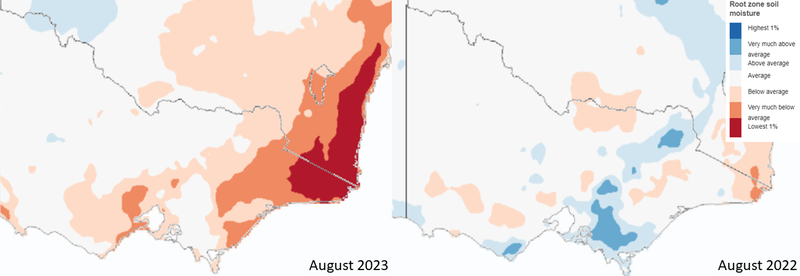Outlook for the 2023 Victorian grass pollen season
Sept. 1, 2023
What the shift from La Niña to El Niño means for your allergies.

Maps showing soil moisture levels in Victoria currently (left) and a year ago (right). Images provided by the Bureau of Meteorology.
Forecasts for the upcoming grass pollen season in Victoria are for a departure from the consecutive "La Niña" weather patterns that have prevailed over the last three seasons. These La Niña seasons typically usher in cooler daytime temperatures and more winter/spring rainfall across eastern Australia. Conversely, the projection for 2023 points towards the emergence of an El Niño pattern, characterized by elevated temperatures and a higher risk of drought.
This shift from La Niña to El Niño will impact the growth and flowering of pasture grasses. The pollen from these grasses acts as the primary trigger for spring and early summer respiratory allergies, occasionally triggering isolated incidents of thunderstorm asthma.
After a series of heavier grass pollen seasons, the outlook for 2023 suggests a return to an average grass pollen season. The prevailing warmer and drier climatic conditions are projected to initiate an earlier commencement of the season compared to the previous year.
This means we’re likely to see the first of our high or extreme grass pollen day in mid-to-late October. High and extreme days are our worst days for hay fever and asthma.
A warmer and drier spring potentially means an earlier end to the season as well.
Recent weather conditions are part of the basis for this outlook. While overall autumn rainfall for the state was close to the norm, the end of August will likely see below average winter rainfall totals and above-average maximum temperatures.
Pivotal to grass growth and flowering is the ability of plants to draw moisture from the soil. Root zone moisture levels serve are an important measure of the water resources available to sustain plant growth. As shown in the first figure, soil moisture levels in the northern and western regions of the state are generally in line with historical averages, while areas nearer to Melbourne show below average moisture levels. Eastern parts of the state are already contending with very dry soils.

Satellite images of vegetation greenness in Victoria in July 2023 (left) and a year earlier (right).
Pasture grasslands are the main land use in Victoria's west and central north. In Melbourne, there are pastures to the west, north, and south, and native forests to the east. The second figure uses satellite-derived imagery of vegetation greenness to show the state of Victorian grasslands in July, relative to the same period last year. Less greenness is seen in northern Victoria compared to the previous year, although this reduction is less pronounced in the southern parts of the state.
The forecast of higher temperatures and reduced rainfall during the spring suggests a low likelihood of additional grass growth. Warmer temperatures will facilitate an earlier onset of grass flowering and also the warm northerly and north-westerly winds that move grass pollen from rain-fed pastures to Melbourne.
However, these conditions should also hasten the drying of grasses following their flowering. This process, known as grassland curing, marks the conclusion of the grass pollen season and start of the grassfire season due to the accumulation of dry vegetation.
Taken collectively, the prevailing condition of Victoria's grasslands and the projection of a warmer and drier spring suggest that 2023 is likely to see an average grass pollen season across Melbourne and much of Victoria. This season is expected to start and end earlier than last year. Melbourne can expect to see around 20 high or extreme grass pollen days between now and the end of the year.
While an average season at this stage looks likely, an important note of caution is that more favorable weather conditions through September would act to increase grass growth and result in a heavier pollen season. Conversely, a much drier and warmer September than normal will reduce grass growth and lead to a lighter pollen season.
We’ll update this forecast again before the start of October.
Where to Get Pollen Count and Forecast Information
Users of the Melbourne Pollen App, available on both the Apple and Google Play Store, can receive notifications about high grass pollen forecast days and thunderstorm asthma warnings issued by the Victorian Department of Health.
You can also follow the team on Twitter, Facebook and Instagram for updates.


